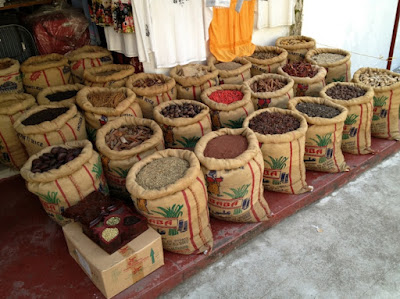Diana Chambers is a world traveler and a member of Sisters in Crime Norcal. She worked on this book idea for years and it's great it's now been published! So, here goes with her fascinating guest post.
THE SECRET WAR OF JULIA CHILD AND ME
By Diana R. Chambers
In my university days, I used to be intrigued to discover connections between seemingly unrelated ideas and concepts, people and places. About ten years ago, I had such a light-bulb moment when I read that Julia Child had served with the OSS in WWII Asia. My brain practically exploded. The Julia Child? In America’s first spy agency? In India and China?!
 |
| Figure 1: China-Burma-India, The Pacific War's Second Front: Museum display, Chongqing, China |
These three elements had connected in a way that seared my brain.
It was like a coup de foudre, love at first sight: I was swept away. This fated discovery has captivated me for the past ten years. But only after The Secret War of Julia Child was finished did I realize that Julia and I had both landed in India at around age thirty. After drifting through our twenties, we both began our formative years.
While I flew into the old Delhi airport in the middle of the night, Julia arrived on a trans-Pacific troopship in Bombay, barely missing a huge explosion in Victoria Harbor before boarding a train across India, then south to the teardrop island of Ceylon, off India’s southeast coast.
 |
Figure 2: Colombo, Sri Lanka railway station: narrow-gauge steam train to Kandy |
Back in the day, I’d studied Indian art history, then continued my studies and explorations of the subcontinent over the years.
 |
| Figure 3: Ajanta caves, India |
I was deep into The Secret War of Julia Child when Penguin India published my novel about a Hollywood actress, the last days of princely India, and the dawn of Independence, The Star of India—with its espionage subplot—in the first months of Covid.
 |
| Figure 4: Cooch Behar Palace |
 |
| Figure 5: Nancy Valentine and HH Jagaddipendra Narayan, the Maharaja of Cooch Behar |
Besides India, I’ve traveled all over China, where The Secret War of Julia Child ends. So I felt on solid ground undertaking a book about Julia’s experiences in the spy trade of WWII Asia.
As it turned out, I was shocked by how much I didn’t know. In school, we’d barely touched on wartime events in what was then known as the Far East—which was to most of us, very far indeed. I realized why it’s known as the “Forgotten War of Asia.” Digging deeper, I discovered how imperialism had shaped regional history—as well as intriguing conflicts between America and Britain, which became a backdrop of this story, Julia’s story. But I also wanted to give justice to the other story: the suffering and sacrifices of the Asian peoples who became swept up in the Second World War.
The Indians put aside their century-long independence struggle to join the global one. The Chinese pressed on with their grueling ten-year war of resistance against the Japanese, holding back the Imperial Army from sweeping across Central Asia to Germany’s aid. Their contribution to fascism’s defeat deserves greater recognition and our profound gratitude.
 |
| Figure 6: Worshipper at the Temple of the Sacred Buddha Tooth, Kandy, Sri Lanka |
 |
Figure 7: Flower Market, Kandy |
As the novel opens, Julia McWilliams has risen to run the Office of Strategic Service’s secret file Registry in Washington, DC, holding the highest security clearance and working directly under OSS founder, General “Wild Bill” Donovan. He later sends her into the field to set up document Registries in Kandy, Ceylon (South East Asia Command), then Kunming in southwest China (China-Burma-India). To the end of her days, Julia honored her vow of secrecy by insisting she was “only a file clerk.” However, given my knowledge of her character, discipline, and drive, I believe it highly likely that Donovan also used her as a trusted source.
Growing up in Pasadena, Julia had been a meat and potatoes girl, barely acquainted with a can opener—until Bombay. At her first taste of the local food, her taste buds salute. The curry! Grilled naan! Fresh pulpy mango juice! All these mysterious little dishes. It’s a revelation. As she discovers a new world of flavor, the world opens up to her. And she plunges right in, heart and soul.
 |
| Figure 8: Kerala spice market |
 |
| Figure 9: Bangalore market |
Then in a former Kandy tea plantation, OSS Detachment 404, she meets chief mapmaker, Paul Child—short, balding, almost forty, a humorless pedant. This annoying man turns out to be a brilliant artist, world traveler—and sophisticated foodie who’s lived in Paris. They’re stuck together on a small base in a distant corner of the world, more than a little reminiscent of Casablanca.
 |
| Figure 10: Reclining Buddha, Kandy temple |
By the time they fly “over the Hump”—the Himalaya—to China and the perilous front lines of Kunming’s Detachment 101, Julia has begun to admire his better qualities, and he’s stopped looking at other women. They continue to share meals...and more.
 |
| Figure 11: “Over the Hump” display, Chongqing Museum |
One thing is certain: The rich and sophisticated cuisine of China remained the couple’s second favorite for the rest of their lives.




Thanks for a very interesting and informative guest post, Diana. All the best with the book.
ReplyDeleteThanks so much, Dietrich! I hope you get the chance to read it.
DeleteAbsolutely fascinating, Diana. Thank you, Cx
ReplyDeleteThanks Catriona!!
DeleteIt's wonderful that you brought this story and your new book to life! Congratulations!
ReplyDeleteI really appreciate being able to reflect on the journey in this post, Susan. Thank you!
Delete